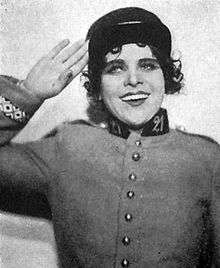Mam'zelle Nitouche
Mam'zelle Nitouche is a vaudeville-opérette in three acts by Hervé. The libretto is by Henri Meilhac and Albert Millaud.
Performance history
It was first performed at the Théâtre des Variétés, Paris on 26 January 1883.
Roles

| Role | Voice type | Premiere Cast, 26 January 1883 (Conductor:Hervé) |
|---|---|---|
| Denise de Flavigny, called "Mam'zelle Nitouche" | soprano | Anna Judic |
| Major, comte de Château-Gibus | baritone | Christian |
| The director | bass | Édouard Georges |
| Célestin, an organist | baritone | Louis Baron |
| Fernand de Champlatreux, lieutenant | tenor | Henri Venderjench ('Cooper') |
| Loriot, a brigadier | tenor | Léonce |
| Mother Superior | contralto | Rosine Maurel |
| Corinne, an actress | mezzo-soprano | Beaumaine |
| Two officers | Gustave, Robert | |
| 'La tourière' | Mériani | |
| Gimblette, an actress | Marguerite | |
| Lydie, an actress | Caro | |
| Students, dragoons, actors, etc. | ||
Synopsis
The story is set provincial France sometime in the 19th century. Denise de Flavigny, a young convent student, discovers a double-life of the organist Célestin, who teaches her music at the convent. He secretly composes popular operettas for his mistress Corinne.
Célestin visits the city to witness the premiere of his latest effort; Denise escapes the convent as well. Following a quarrel with Célestin, Corinne walks out and instead, Denise appears in her role, taking the name Mam'zelle Nitouche. Denise falls in love with Fernand, a handsome young soldier. Both Denise and Célestin are mistaken for soldiers absent without leave and shipped off to an army camp. A series of coincidences brings happiness to all concerned.
Title
Mam'zelle Nitouche can loosely be translated as Little Miss Hypocrite; the title is derived from the French expression "sainte nitouche" (literally "(female) Saint Wouldn't-Touch-It") for a female hypocrite. Mam'zelle is a graphic form or bastardisation of "mademoiselle", French for "miss".
Films
Mam'zelle Nitouche has been the subject of a number of films:
- a 1931 French film directed by Marc Allégret, and Mam'zelle Nitouche
- Mamsell Nitouche, a 1932 German language version directed by Carl Lamac
- a 1954 film directed by Yves Allégret, with Fernandel.
- The Danish film Frøken Nitouche from 1963 is based on this work.
- Nebesnye lastochki (aka Swallows in the Sky or Heavenly Swallows), Soviet movie, 1976, directed by Leonid Kvinikhidze, screenplay by Leonid Kvinikhidze, with Andrei Mironov.